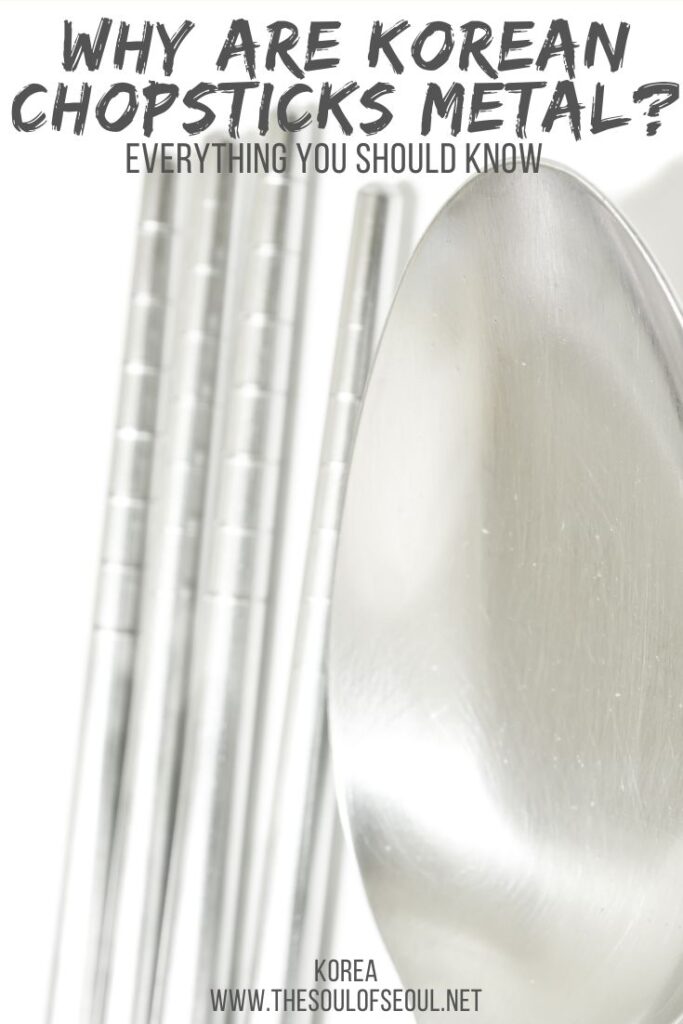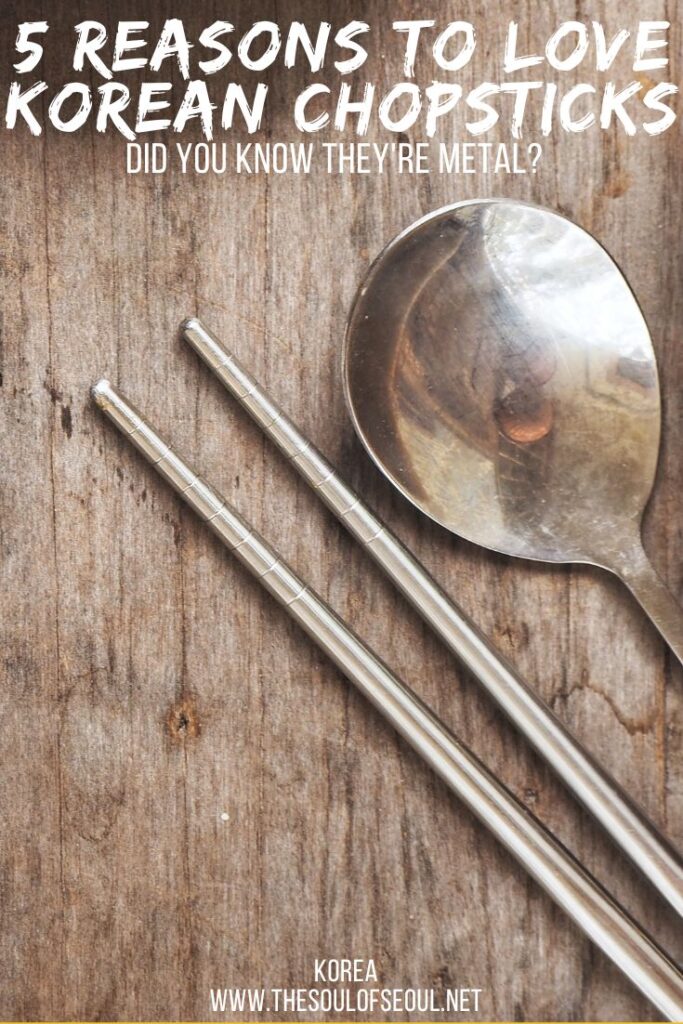Everything You Should Know About Korean Chopsticks & How To Use Them
Last Updated on October 16, 2023
One of the first things travelers notice when they sit down to eat in Korea is that their chopsticks are metal not wooden like they’re used to back home when ordering Asian food. Using metal chopsticks is a whole new obstacle, but we’ll get to that.
There are so many reasons to love Korean chopsticks. They’re eco-friendly, sustainable, and while it might be difficult to learn how to use them at first, they will make you more dexterous. Here’s how to use chopsticks and why to love them.
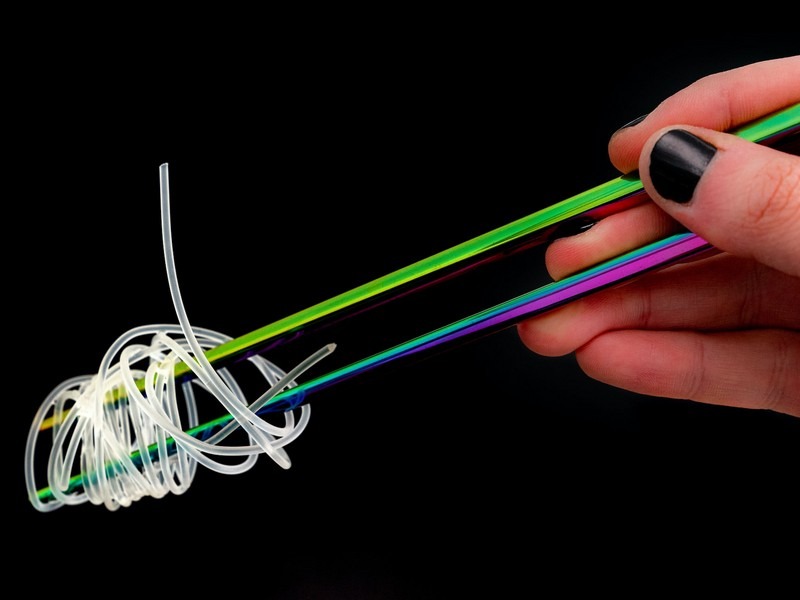
Learn everything about the Korean metal chopsticks:
- How do you say chopsticks in Korean?
- The History of Korean Chopsticks
- What do Korean chopsticks look like
- Chopsticks aren’t all the same length
- Proper etiquette when using Korean chopsticks
- How to use chopsticks step by step
- Three ways to get better at using chopsticks
- 5 reasons to love Korean chopsticks
(This post contains affiliate links, which means I receive a certain percentage of a sale if you purchase after clicking at no cost to you. Thank you for your support.)
How do you say chopsticks in Korean?
Chopsticks: jeotgarak (젓가락)
Since we’re at the table, let’s go over a few more Korean vocabulary words that you should know.
Spoon: sukgarak (숟가락)
Spoon and chopsticks set: sujeo (수저)
Are you ready to learn Korean? If you plan to visit Korea or to live in Korea, I highly recommend learning some basic Korean at the very least. It’ll go a long way and people will respond a lot more. Want to know where to start? Check out this list of the best books to learn Korean with. If you want a more interactive online course, check out the best online Korean courses that you can join.
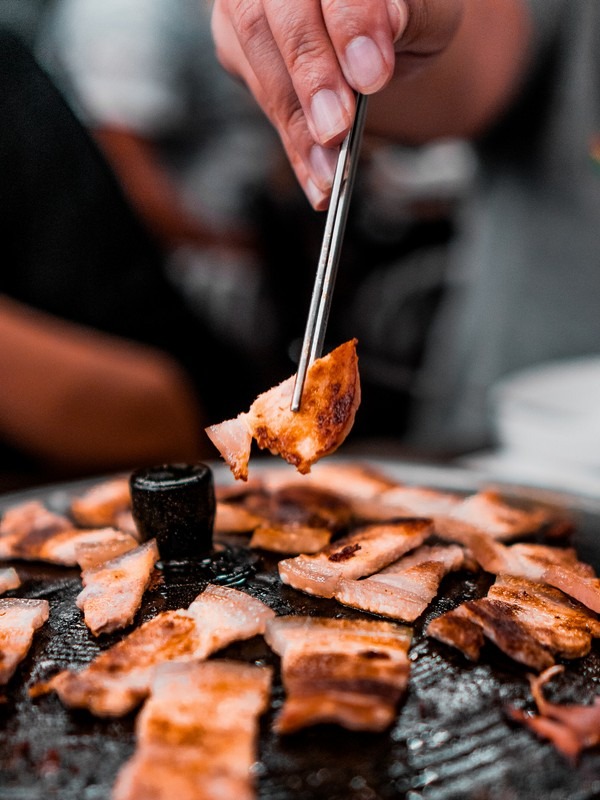

The History of Korean Chopsticks
The tradition of eating with chopsticks originated in China and spread from there to Japan and Korea in 500AD. In Korea, metal chopsticks became a symbol of social status starting in the Baekje Kingdom under King Muryeong. This was proven when metal chopsticks were found in the tomb of King Muryeong of Baekje.
At the time, silver chopsticks were used to detect arsenic in food and then in the Goryeo Dynasty, they used bronze chopsticks to detect poisons. It wasn’t uncommon for rivalry royal families to attempt to assassinate each other. Some families had official ‘food tasters’ to try the food before a member of the royal family ate. The silver spoon and chopsticks would discolor when they came in contact with poisons or chemicals.
While the common people were using wooden or brass chopsticks, the royalty were using gold and silver and then metal chopsticks began to trickle down though in more affordable metal options. (This is similarly how the Korean name stamp became so common place in Korea.)
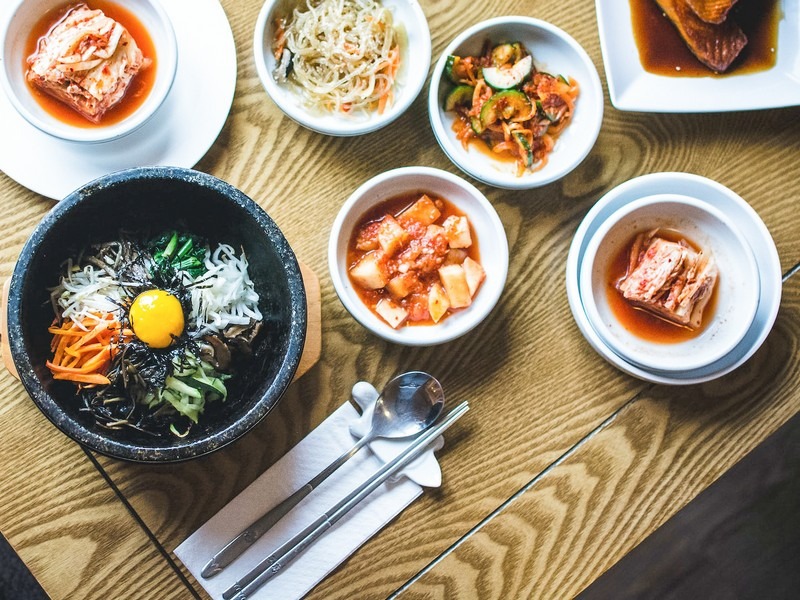
What do Korean chopsticks look like
Korean chopsticks are smooth and flat though there has been an influx of the rounder tubular chopsticks entering the market under the title of Korean chopsticks. Though they work similarly, they are made in more of the Japanese style and shape. They are metal though which is very Korean chopstick style. Korean chopsticks are noticeably heavy. If you’re used to using wooden chopsticks, the heaviness of the Korean chopsticks will stand out to you.
Chopsticks aren’t all the same length
A lot of people that first arrive in Korea don’t only notice that the chopsticks are metal, but they also notice that they’re longer than they’re used to.
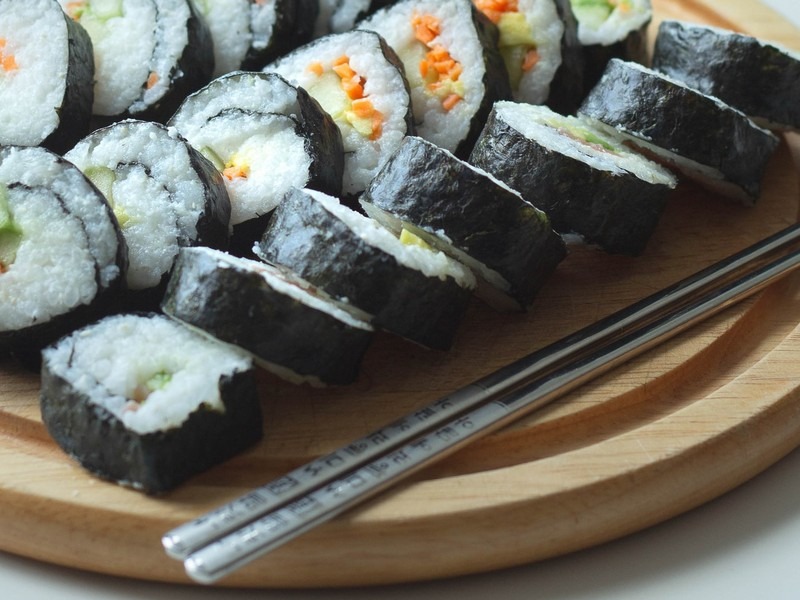
Japan has the shortest chopsticks but this is because they don’t share food so don’t need to reach across the table. Historically, they actually had different lengths for men and women. Made from bamboo with a pointed end, in the past wealthier people ate with ivory or jade chopsticks. The chopsticks are pointier since they eat a lot of fish and they help remove fish bones.
China has the longest chopsticks that are blunt instead of pointed. Chinese chopsticks are longer because they share food and they use them to cook and being longer prevents burns when reaching into hot pots.
Korean chopsticks are made out of stainless steel or silver and are longer than Chinese chopsticks but shorter than Chinese chopsticks. Usually, the chopsticks are 9 inches to 10 inches long.
Oh but when it comes to kids, they usually start with shorter chopsticks to get used to using them.
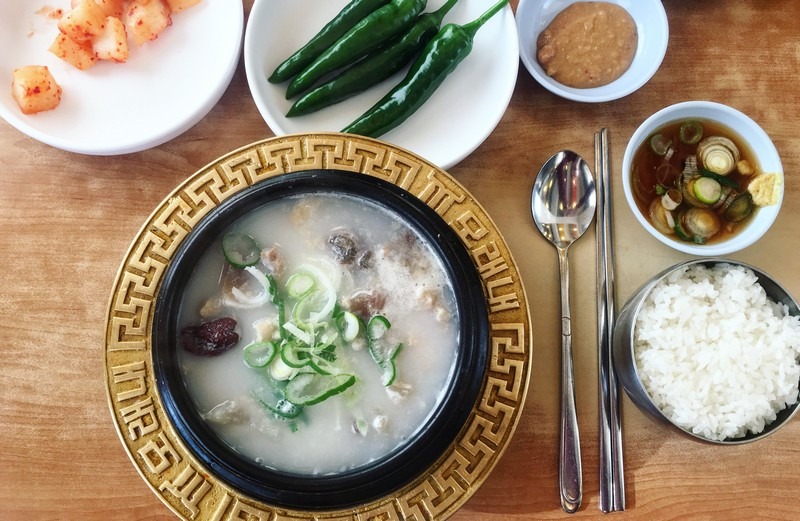
Proper etiquette when using Korean chopsticks
You’ll find chopsticks and spoons gracing the tables of Korean tables in sets that are called ‘sujeo’ (수저). It’s always good to be aware of proper table manners and eating etiquette when you travel abroad so you don’t make any cultural faux pas. When it comes to Korean chopsticks, there are some specific things to know.
- Eat everything you touch. Since sharing culture is big at the Korean table, it’s important to take what you touch. Take food from the shared plate, place it on your plate or in your bowl and then eat it. If you don’t want to eat something but did touch it, you should still move it to your plate if you’ve touched it with your chopsticks.
- Do not stick your chopsticks straight into your rice so they’re standing up out of the bowl. When stuck straight into the bowl, they can resemble incense that is traditionally burned during funerals or ancestral rights. There are a number of Korean superstitions about chopsticks and this is an important one.
- Don’t lay your chopsticks across the top of your bowl. Lay them down on the table or on the chopsticks stand.
- Do not stab or prick the food on the table.
- The chopsticks and spoon should be placed on the right side of the dish. Chopsticks should be placed to the right of the spoon.
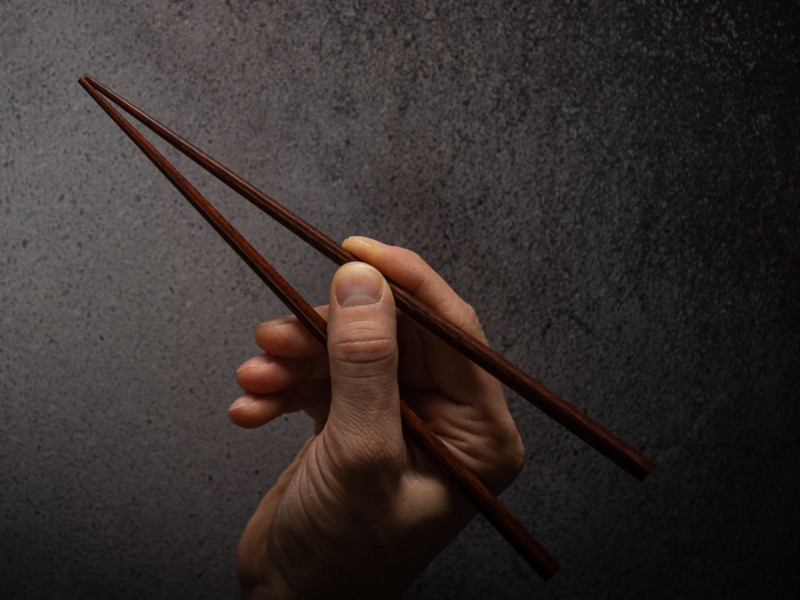
How to use chopsticks step by step
The flat smooth shape of Korean metal chopsticks can make them a bit difficult to grip and use at first when you’re not used to them, but they can ultimately offer a stronger grip. Korean chopsticks require greater muscle control but you can learn to use them skillfully. I suggest getting a bowl of corn, peas, or something similar to practice on.
Step 1: Place the back end, not the food end, of the first chopstick in that web between the thumb and pointer finger. The front end of the chopstick then rests on the ring finger (and your pinky underneath it). This chopstick shouldn’t move when you’re using chopsticks, FYI.
Step 2: The second chopstick is held similar to pencil. Your thumb, index finger, and middle finger hold this chopstick and this is the one that moves up and down when you’re getting food and eating.
Step 3: Once both are in your hands this way, you should practice touching the two food touching ends of the chopsticks to each other. Remember, just the top chopstick actually moves to meet the bottom chopstick.
*Don’t hold the chopsticks too close to the end that picks up food. Not only is that a bit of a faux pas, but it also just makes it more difficult. You’ll have greater dexterity if you hold them closer to the other end, about half way between the halfway point of the chopsticks and the end of them is the best place to hold them. All of that to mean, you should hold them about 2/3’s the way up from the food end.
Three ways to get better at using chopsticks
Using chopsticks adeptly takes some practice and plenty of people end up getting into bad habits with their chopsticks too when not practiced properly. When I first arrived in Korea, I didn’t know how to use chopsticks and the woman who ran our local dinner stop would bring me out a dish of beans, corn, or something else that was small to practice on before my food was ready. I’ve had my chopsticks skills complimented on and even beat my Korean husband in chopsticks races so I like to think I’m pretty good now. Here are three things you can do to get better at using chopsticks.
- Get two bowls, or a bowl and your mouth work too. Fill one bowl with an item of food. It should be something that’s small like peas, corn, beans. Try to pick them up and place them in the other bowl or in your mouth. We’ve done this one at family reunions too and it makes for a thrilling race.
- Use chopsticks as often as you can to eat. If you really want to get better at eating with chopsticks, just start eating with chopsticks regularly. Don’t use it for specific foods, but use it for everything. Koreans use chopsticks and a spoon, so get a spoon, your chopsticks, and go from there.
- Color coordinate something. Get out some pom-pom balls or some colorful legos. Ideally something bigger than the peas and corn from above so you can practice lifting something of a different size. Separate the items by color and see how fast you can do it. Time yourself, and do it again, and again until you get faster.
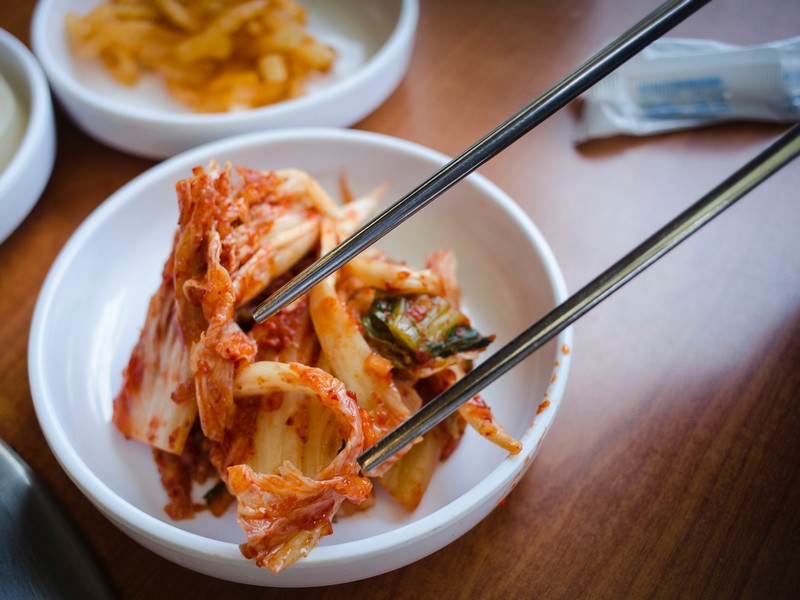
5 reasons to love Korean chopsticks
1 Korean chopsticks are eco-friendly. Being made out of metal instead of wood or bamboo makes them extra durable, anti-corrosive, and reusable.
- Just an FYI, it is recommended to discard bamboo chopsticks after three to six months of use.
2 An old Korean superstition says that the closer to the tip you hold a pair of chopsticks, the longer you will remain unmarried.
3 Korean chopsticks are easier to clean. Being made from stainless steel and featuring a sleek design, cleaning is super easy and metal chopsticks are dishwasher safe.
4 After the Korean War, the government actively encouraged people to use more reusable metal chopsticks instead of any wooden ones to support the Korean steel industry and let the ravaged Korean forests regrow.
5 Some people say eating with chopsticks slows them down. I’ve seen my husband polish off a meal in 15 minutes with chopsticks though so this might just be for the slow eaters. But, eating more slowly is healthier.
Did you like this post? Pin IT!
